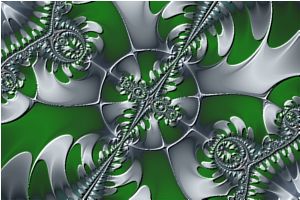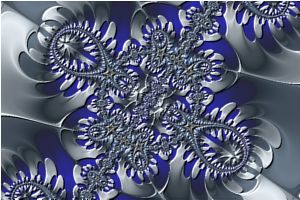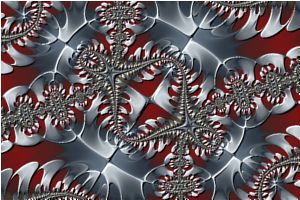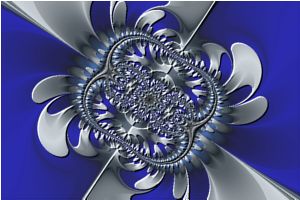
Feathered Steel Examples

Feathered Steel I |

Feathered Steel II |

Feathered Steel III |

Feathered Steel IV |
The Feathered Steel examples are Newton Fractals based on the equation Carlson - Newton 2. They use Embossing to achieve an etched metal look.
Note: When you turn off Anti-Aliasing to increase performance as you explore, as recommended in the Fractal Science Kit Examples Overview, the Embossing effect is overpowering. You can deal with this in two ways:
- The simple strategy is to do nothing and know that when you turn Anti-Aliasing back on to generate any image you want to save, the Embossing will look great.
- You can set the Embossing Weight to Light, or turn it off altogether, and then set it back to Normal when you turn Anti-Aliasing back on.
Zoom In/Out
Zoom In or Zoom Out to examine different parts of the fractal.
Execute the Home command on the View menu of the Fractal Window to reset the fractal to the default position/magnification, and then Zoom In to other areas.
Remember that as you Zoom In, you may need to increase the Max Dwell property found in the Orbit Generation section of the General page.
Play with the Fractal Equation's Properties
You can change the equation's properties for more variations.
Select the equation's properties page:
General
Mandelbrot / Julia / Newton
Fractal Equation: Carlson - Newton 2
Properties
Play with the equation's properties.
Change the Julia Constant
You can generate other Julia Fractals based on the same equation.
Select the Fractal Equation:
General
Mandelbrot / Julia /
Newton
Fractal Equation: Carlson - Newton 2
Uncheck the Julia checkbox, execute the Home command on the View menu of the Fractal Window to reset the Mandelbrot fractal to the default position/magnification, and use the Preview Julia command to explore the Mandelbrot's many different Julia Fractals. See Working with Julia Fractals for details.
Alternatively, you can change the Julia Constant property on the Fractal Equation page, and then click the Preview Fractal toolbar button on the Properties Window to generate a preview of your change in the Preview Window.
Change the Fractal Equation
You can change the Fractal Equation used to generate the fractal.
Select the Fractal Equation:
General
Mandelbrot / Julia / Newton
Fractal Equation: Carlson - Newton 2
Change the Based On property to one of the following Fractal Equations:
- Newton 1
- Newton 2
- Newton 3
- Newton 4
- Newton 5
- Newton 6
- Newton 7
- Newton 8
- Newton 9
- Newton 10
- Newton 11
- Newton 12
- Carlson - Newton 1
- Carlson - Newton 2
- Carlson - Newton 3
- Newton Composite Function
- Newton Poly 4a
- Newton Poly 4b
- Newton Poly 4c
- Newton Poly 5a
- Newton Poly 5b
- Newton Poly 5c
- Newton Poly 5d
- Newton Poly 6a
- Newton Poly 6b
- Newton Poly 6c
- Newton Poly 7a
- Newton Poly 7b
- Newton Poly 7c
Then execute the Home command on the View menu of the Fractal Window to reset the Mandelbrot fractal to the default position/magnification, and use the Preview Julia command to explore the Mandelbrot's many different Julia Fractals. See Working with Julia Fractals for details.
Remember to navigate to the properties page for the equation (found under the equation in the page hierarchy) and play with the different properties found there. Many of the equations support properties that can be used to generate lots of different variations.
Change the Transformation
You can apply a transformation to the fractal.
Execute the Home command on the View menu of the Fractal Window to reset the fractal to the default position/magnification before you adjust the transformation. Then change the transformation and Zoom In to interesting areas of the transformed image.
To change the transformation applied to the fractal, select the transformation's properties page:
General
Mandelbrot / Julia / Newton
Transformation
Composite
Function
Properties
Set the F(z) property to one of the complex functions in the list. You can change some of the other properties on this page for more variations.
You can also use a different transformation altogether. Select the Composite Function page, and change the Based On property to select a transformation and then open the transformation's properties page (found under the transformation in the page hierarchy), and play with the transformation's properties. See Transformation Support for details.
To add additional transformations, select Transformation:
General
Mandelbrot / Julia / Newton
Transformation
Click the New toolbar button to add a new Identity transformation to the bottom of the list, and then click the Move Up toolbar button to move the new transformation to the desired position in the list. Normally, I move the new transformation to the top of the list, but it can be placed anywhere. See Transformation Array for details.
Then select the Identity transformation:
General
Mandelbrot / Julia / Newton
Transformation
Identity
Change the Based On property to select a transformation and then open the transformation's properties page (found under the transformation in the page hierarchy), and play with the transformation's properties. See Transformation Support for details.
Play with Color
To play with color, select the color controller's properties page:
General
Mandelbrot / Julia /
Newton
Classic
Controllers
Gradient Map - Value/Overlay
Properties
Change the Power, Factor, and/or Offset associated with the Value or Overlay to change how the colors are mapped onto the image.